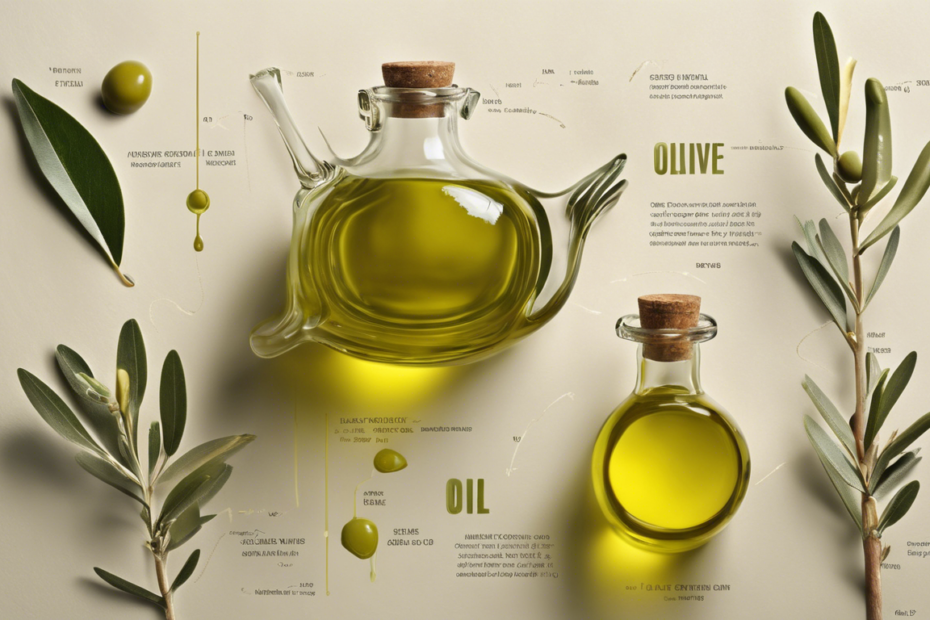Ever wondered what makes olive oil such a beloved ingredient in kitchens around the world?
Beyond its rich flavor and culinary versatility lies an intricate chemical composition that contributes significantly to its health benefits.
In this article, we’ll dive deep into the olive oil chemical formula, exploring the fascinating fatty acids, powerful antioxidants, and other compounds that make olive oil not just a staple in your pantry but also a powerhouse for your health.
Let’s unlock the secrets together!
Key Takeaways
- Olive oil is primarily composed of fatty acids, each contributing to its unique flavors and health benefits.
- Antioxidants and other compounds in olive oil play a crucial role in its quality and health advantages.
- Understanding the chemical formula of olive oil helps consumers make informed choices about their cooking oils.
- The health benefits of olive oil are closely tied to its chemical properties, particularly its high antioxidant content.
- Choosing high-quality olive oil can enhance both your cooking and overall well-being.
1. The Composition of Olive Oil: An Overview of Its Fatty Acids
When diving into the world of olive oil, one of the first things to appreciate is its rich chemical composition, starting with its fatty acids.
The olive oil chemical formula reveals a high concentration of monounsaturated fatty acids, particularly oleic acid, making up around 55-83% of its total fatty acid content.
This is what gives it that smooth, buttery flavor and helps set it apart from other oils.
But it doesn’t stop there; the oil is also packed with a variety of antioxidants such as vitamin E and phenolic compounds, which not only contribute to its unique taste but also play a critical role in preserving its freshness and extending shelf life.
These phytochemicals not only combat oxidative stress but also bring a bunch of health benefits, from reducing heart disease risk to potentially lowering inflammation in the body.
So, whether you’re drizzling it over a salad or using it for cooking, understanding the chemical intricacies of olive oil not only enhances your appreciation of this versatile ingredient but also highlights why it’s such a staple in healthy diets around the globe.
2. The Role of Antioxidants and Other Compounds in Olive Oil
When you dive into the chemistry of olive oil, it’s fascinating to see just how complex yet beneficial it is!
Essentially, olive oil’s chemical formula mainly comprises triglycerides, which are made from glycerol and fatty acids.
The predominant fatty acids in olive oil include oleic acid (about 55-83%), palmitic acid (7.5-20%), and linoleic acid (3.5-21%), each playing a crucial role in giving olive oil its characteristic flavor and health properties.
But that’s not all—olive oil is also packed with antioxidants like vitamin E and polyphenols that not only contribute to its shelf life but also combat oxidative stress in our bodies.
These antioxidants are believed to be responsible for many of the impressive health benefits associated with olive oil, such as reducing inflammation and lowering the risk of chronic diseases like heart disease.
So, when you drizzle that golden liquid on your salad or use it for cooking, you’re not just adding flavor; you’re incorporating a powerhouse of health-boosting compounds!
‘Let food be thy medicine and medicine be thy food.’ – Hippocrates
3. Health Benefits Linked to the Chemical Properties of Olive Oil
Olive oil isn’t just a tasty addition to your meals; it’s packed with immense health benefits that tie right back to its chemical formula.
Rich in monounsaturated fats, particularly oleic acid, olive oil boasts a unique makeup that helps reduce inflammation and lower bad cholesterol levels in your body.
This is important not just for heart health but also for keeping your overall wellness in check.
Plus, the antioxidants, like vitamin E and polyphenols found in olive oil, play a crucial role in combating oxidative stress, which can lead to chronic diseases.
So next time you drizzle that golden liquid over your salad, know that you’re not only enhancing the flavor but also potentially boosting your health, thanks to the fascinating chemistry behind olive oil!
Frequently Asked Questions
What is the chemical formula of olive oil?
Olive oil primarily consists of triglycerides, which have the general chemical formula C55H104O6.
The exact composition can vary based on the type of olives used, but this formula represents the fatty acid components.
What fatty acids are found in olive oil?
Olive oil predominantly contains monounsaturated fatty acids, especially oleic acid, which makes up about 55-83% of its total fatty acid content.
It also contains polyunsaturated and saturated fatty acids in smaller quantities.
What antioxidants are present in olive oil?
Olive oil is rich in antioxidants, including vitamin E and phenolic compounds.
These antioxidants help protect the oil from oxidation and contribute to its health benefits.
How does the chemical composition of olive oil contribute to its health benefits?
The monounsaturated fats in olive oil can help reduce bad cholesterol levels, promote heart health, and lower the risk of chronic diseases.
Additionally, the antioxidants in olive oil can combat inflammation and oxidative stress.
Can the health benefits of olive oil be affected by how it is processed?
Yes!
The processing methods can impact the chemical composition and health benefits of olive oil.
Extra virgin olive oil, which is cold-pressed, retains more of its beneficial compounds compared to more refined oil.


